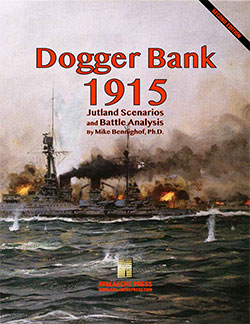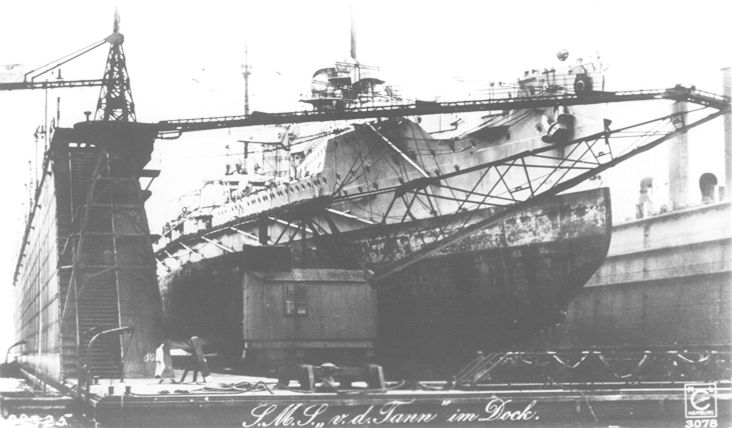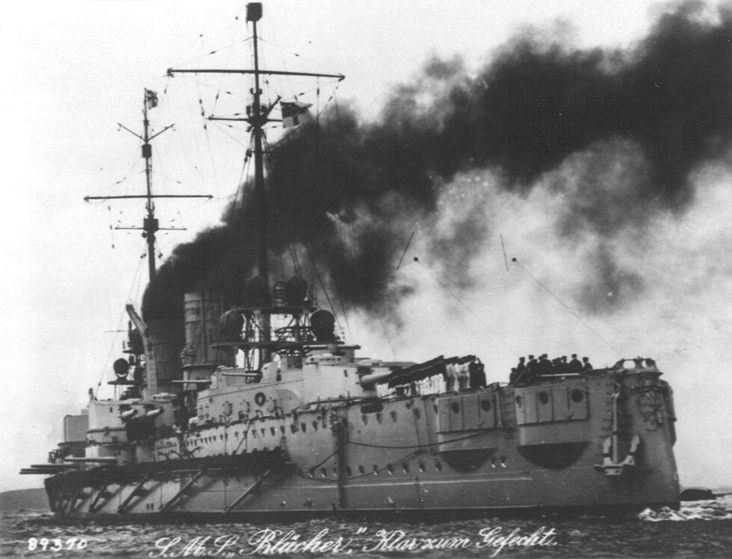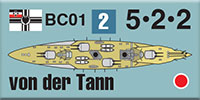| Jutland:
The Battle of Dogger Bank, Part One
By Mike Bennighof, Ph.D.
November 2024
Don’t put up a damn memorial for me unless I’ve done something. - Franz Hipper
 Located in the North Sea about sixty miles off the north-east coast of England, the Dogger Bank is noted as a rich fishing ground where cod and herring are still taken in commercial quantities. Dogger Bank fishing boats were famously attacked by the Russian Baltic Fleet in October 1904, and when the First World War broke out a decade later, they continued to trawl for fish, with British, German and neutral boats continuing to ply the waters. Document XI of the 1907 Hague Convention protected fishing fleets from enemy attack, but such niceties did not survive for long. Located in the North Sea about sixty miles off the north-east coast of England, the Dogger Bank is noted as a rich fishing ground where cod and herring are still taken in commercial quantities. Dogger Bank fishing boats were famously attacked by the Russian Baltic Fleet in October 1904, and when the First World War broke out a decade later, they continued to trawl for fish, with British, German and neutral boats continuing to ply the waters. Document XI of the 1907 Hague Convention protected fishing fleets from enemy attack, but such niceties did not survive for long.
Fishing had been vital to the pre-war German economy; the total value of the German North Sea fisheries before the war had been £1.7 million for 138,000 tons of fish, landed by 701 boats employing over 6,800 crewmen - more than three times the value of the Baltic fisheries. In November 1914 the British declared an economic blockade of Germany, sweeping those boats from the Dogger Bank and denying Germany a valuable food source.
That left the banks to British and neutral boats, and some German sea officers came to believe that the British were using these boats to spot German warships and radio their locations to the Royal Navy. The British had clearly known that the Germans were at sea during the December 1914 raid on Scarborough; some attributed this knowledge to spies in the dockyards, but others including High Seas Fleet chief of staff Vice Admiral Richard Eckermann and scouting forces commander Rear Admiral Franz Hipper blamed the fishing boats.
The Germans were not completely wrong; the British did have early warning of many of their operations, thanks to decoded radio intercepts. Despite the presence of all the key officers and ships in Wilhelmshaven, the German flagship still repeated orders over wireless even when they had already been delivered verbally, in writing, or both. In October 1914, Capt. Reginald “Blinker” Hall had been shifted from command of the battle cruiser Queen Mary to head the Royal Navy’s radio intelligence section known as “Room 40.” Hall’s wife had secretly written to the former director, begging that her husband receive a short appointment before stress and anxiety killed him, and he found his calling in code-breaking.

The Iron Dog.
Eckermann insisted that the fishing boats were the culprit, and should be chased off the Dogger Bank. Though he apparently spoke only of their role as sea-going spies, the thought of retaliating for the illegal banning of German fishing boats from the rich grounds likely played a role as well. Hipper liked the idea, since he believed that British scouting forces - light cruisers and possibly destroyers - also patrolled the Dogger Bank and could be overwhelmed and destroyed.
Hipper proposed combining the sweep of the Dogger Bank with a mining operation off the First of Forth, where the British were suspected of having based at least some of their heavy ships at the small port of Rosyth. Light cruisers would undertake both operations, with the battle cruisers nearby in support and the battleships of the High Seas Fleet out to offer distant support.
Daily Content includes no AI-generated content or third-party ads. We work hard to keep it that way, and that’s a lot of work. You can help us keep things that way with your gift through this link right here.
The plan appeared stillborn as foul weather covered the North Sea, but on 22 January - just after Operation 21 had been formally postponed until 7 February - it suddenly cleared. Eckermann persuaded his boss, Friedrich von Ingenohl, to go ahead with the mission and the fleet commander gave Hipper the verbal order to do so. But he made some last-minute modifications to the plan. Not expecting the weather to clear, Ingenohl had approved the deployment of his III Battle Squadron to the Baltic for gunnery exercises, taking with them all of the most modern dreadnoughts including the fleet flagship Friedrich der Grosse. The High Seas Fleet was left with the eight oldest dreadnoughts and the eight most modern pre-dreadnoughts; Ingenohl shifted his flag to the pre-dreadnought Deutschland, the previous fleet flagship. He told Hipper that the risk of British spies spotting the fleet’s preparations was too great and would spoil the element of surprise; the battle fleet would not come out in support.

SMS Von der Tann in drydock.
Given the postponement, Hipper had approved a yard period for his oldest battle cruiser, von der Tann. The ship entered drydock just as Ingenohl decided to go forward with the mission. That reduced Hipper’s First Scouting Group to three battlecruisers (his flagship Seydlitz, Moltke, and the recently-arrived Derfflinger, soon famed as the Iron Dog) and the large armored cruiser Blücher. Released from their ship when she entered drydock, roughly two hundred von der Tann crewmen streamed aboard Blücher to reinforce her stokers and gunners for the coming fight.
In the aftermath of the battle Hipper seems to have second thoughts about having brought the weakly-armored Blücher along on the operation, and writers have questioned this judgement for over a century. All of that overlooks that there was really no decision involved. Blücher had participated in all of the First Scouting Group’s missions since the beginning of the war, and that alone was noteworthy. Her old-style vertical-expansion engines generated less power and therefore less speed than the turbines of the true battle cruisers, but they were significantly more reliable. All of the battle cruisers needed repeated yard periods, often for work on their turbines. Blücher was always ready for action.
Her lesser speed existed mostly on paper; thanks to the poor-quality coal afflicting the High Seas Fleet, several of the battle cruisers had trouble meeting their designed speed while Blücher always hit hers of 23.5 knots and often exceeded it. Blücher had served as the fleet’s gunnery training ship before the war and as a test bed for gunnery experiments even after the war began; just before the Dogger Bank sortie she received a new Siemens-built fire director system. Her guns had a much greater elevation than those of the battle cruisers, and as a result her smaller 210mm (8.2-inch) guns actually outranged the bigger weapons of the bigger ships. She retained many of her gunnery experts and shot extremely well. Without the benefit of hindsight, Hipper would have seemed foolish to leave her behind.

Armored cruiser Blücher.
Where Hipper can be criticized is for his decision to allow von der Tann’s yard period to proceed. At the moment Ingenohl gave him his verbal orders, work on the big cruiser couldn’t have been very advanced and it should have been possible to extract her from the dock and send her crew back on board. Hipper appears to have never considered this option and the work proceeded as scheduled; von der Tann floated out of the dock on 3 February.
There’s also the question of just why the First Scouting Group had to be deployed at all. The light cruisers of Second Scouting Group would do all the heavy lifting, both laying mines and smacking the fishing smacks. Without the High Seas Fleet in his back pocket, Hipper would be badly out-numbered by the newly-established British Battle Cruiser Fleet alone and totally overpowered if the Grand Fleet were at sea.
Even so, the operation had a good chance of success until 1010 on 23 January 1915. Despite the fact that Hipper already had his orders, following usual practice Deutschland broadcast the operational order to the High Seas Fleet, with the Scouting Groups scheduled to sail that evening. Room 40 immediately intercepted the message, and by noon had decrypted it. At 1225 orders went to Sir David Beatty, Battle Cruiser Fleet’s commander, to sail immediately to intercept. Hipper and his cruisers left the Jade roadstead outside Wilhelmshaven at 1745.
“No one on board had any idea,” Capt. Hugo von Waldeyer-Hartz wrote after the war, “that the plan was known to the enemy and that every movement and disposition was followed as accurately as if the British themselves were directing them.”
You can order Jutland: Dogger Bank right here.
The Jutland Experience
 Jutland Second Edition (full game) Jutland Second Edition (full game)
Jutland: North Sea 1914
Jutland: Dogger Bank
Journal No. 46: Iron Dogs
Retail Price: $179.96
Package Price: $150.00
Gold Club Price: $120.00
You can order the Jutland Experience right here.
Please allow an extra two weeks for delivery.
Sign up for our newsletter right here. Your info will never be sold or transferred; we'll just use it to update you on new games and new offers.
Mike Bennighof is president of Avalanche Press and holds a doctorate in history from Emory University. A Fulbright Scholar and NASA Journalist in Space finalist, he has published a great many books, games and articles on historical subjects; people are saying that some of them are actually good.
He lives in Birmingham, Alabama with his wife, three children, and his new puppy. His Iron Dog, Leopold, could swim very well.
Daily Content includes no AI-generated content or third-party ads. We work hard to keep it that way, and that’s a lot of work. You can help us keep things that way with your gift through this link right here.
|
